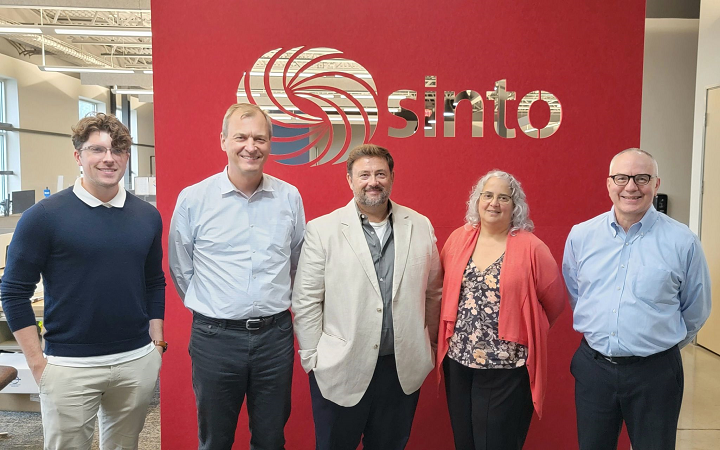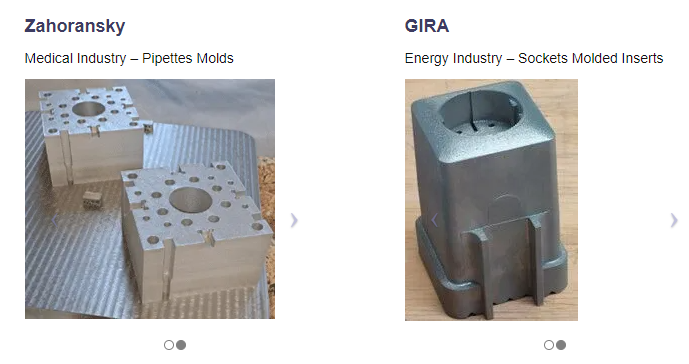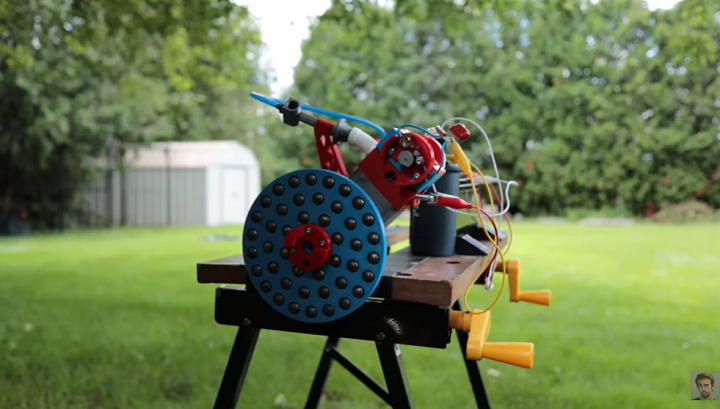In today’s 3D Printing News Briefs, Germany’s largest AM bureau has invested in Dimensionics Density’s technology, 3DCeram Sinto and Sintx Technologies are collaborating to develop materials and technologies for advanced ceramics 3D printing, and AddUp and the WBA completed a consortium study on metal AM for tooling molds. Researchers from HUST created a new substance that makes 3D printed toilets more slippery. In Japan, architects have used desktop 3D print and wood joinery to build a tea house. A YouTuber has 3D printed an engine made of plastic.
FKM Invests In Automatic Density Determination Technology

FKM Additive Manufacturing
Germany’s largest full-service powder bed fusion (PBF) 3D printing bureau, FKM, has invested in the automatic density determination technology of Dimensionics Density. Automating AM chain tasks such as part design optimization and slicing along with material handling, 3D Printing, post-processing and validation will reduce human error, increase production speed and improve precision, while maintaining strict quality controls. FKM covers the entire AM process chain, from design and powder characterization to parameter optimization and post-processing, and will use Dimensionics Density’s technology to move towards a fully automated and streamlined AM workflow. Automation of the AM process chain can speed up production and reduce waste. It also lowers costs and allows for complex geometries.
“As more and more of our customers look to AM as a production technology, it is increasingly important for us to optimise an array of strict quality control processes, giving confidence in outcomes, and therefore cementing customer relationships. We need a non-destructive, fast and accurate density testing method for AM due to the high volume of parts and build jobs we produce every day. After studying the report on measurement methods for density determination in AM which was conducted by the Fraunhofer IAPT in Hamburg, we decided to assess Dimensionics Density’s technology,” said Stefan Behlert, Head of Quality at FKM. “In order to verify the technology, Dimensionics Density offered free testing of samples and the calculation of an ROI according to the number of samples FKM aims to measure each year. Both delivered convincing results which led to an order of one machine for the quality laboratory at FKM.”
3DCeram Sinto & Sintx Technologies Collaborate for Advanced Ceramics AM

Sintx Technologies has started a successful collaboration with 3DCeram Sinto Inc. The teams recently had a successful meeting at 3DCeram.’s facility in Grand Ledge, MI for printing trials and sales opportunity planning. (Image courtesy Sintx via LinkedIn)
Sintx Technologies, Inc., the leading manufacturer of advanced biomedical technical ceramics, and 3DCeram Sinto, Inc., the turnkey provider in advanced ceramics AM, collaborate to develop new resins and processes, specifically for biomedical products and investment casting. The two companies are leaders in the industry, both with extensive backgrounds in advanced ceramics and additive manufacturing. They plan to combine their knowledge to produce high-value ceramic resins, 3D print ceramic components, then process them using advanced thermal processing. The two believe that their combined results will help “to drive expanded geographical adoption” of 3D printed advanced ceramics, as there’s been increased interest for those capabilities around the world.
“We are excited about the possibilities of creating a silicon nitride-based resin for the biomedical market. As the market for silicon nitride-based medical devices continues to grow, we think that 3D-printed silicon nitride will play an important role in future segments of the medical and technological sectors in which we operate. We believe that SINTX’s resin formulation and densification expertise, combined with 3DCeram’s production scale printers, will provide the market with components of superior quality,” said Dr. Sonny Bal, CEO of Sintx Technologies.
Metal AM Tooling Study by AddUp & the WBA

AddUp, a global metal AM OEM of powder bed fusion systems (PBF), established the AM Tooling Competence Centre at Aachen in early 2023 with the Werkzeugbau-Akademie. This was one of AddUp’s previous partners. The facility, which also serves as AddUp’s German subsidiary, was created to accelerate the adoption of metal AM by tooling companies and is equipped with a FormUp 350 PBF machine; toolmakers can submit application cases to use the Centre for evaluation and to study all aspects of their project. AddUp and WBA have conducted a consortium AM Tooling Study in conjunction with six selected tool-making firms to examine the adoption of metal AM mold making. They also delivered the first prototypes for injection molds that feature optimized internal cooling channels.
The participating companies are Siebenwurst, Zahoransky, GIRA, Pöppelmann, Harting, and FRAMAS, and they had the chance to implement the technical and economic advantages of AM for their injection molds. The performance of a mold relates to its ability to cool injected parts, and PBF printing can be used to create complex cooling channels, which are then positioned as close as possible to the mold walls and can cool the part’s surface more homogeneously. AddUp evaluated the case studies of these companies for parts that were traditionally manufactured using conventional machining techniques. They were then designed for AM, optimized to conformal cool, and 3D-printed on the FormUp350. Post-processing is completed by either the WBA, or the tooling firm itself. Each ready-to-use mold was sampled on the company’s production lines, and comparative data will be provided to the WBA. The WBA will publish the results of the first Tooling Study during its General Assembly, which takes place in the fourth quarter of 2023.
The 3D-printed slippery toilet could reduce water usage

Test the mini toilet with dyed honey
There are several kinds of slippery toilet surfaces, such as Teflon coating, but the more they’re used, the less slippery they become, so either the coating or the toilet must be replaced to remain effective. But a new material developed by researcher Yike Li and his colleagues at China’s Huazhong University of Science and Technology (HUST) could change that, as it made a toilet so slippery that hardly anything could stick to it, even after heavy use and in the face of abrasion. The new material could not only reduce the amount water used to flush toilets, but it may also eliminate the need for cleaning them. The team made a small model of toilet with SLS 3D printers and a mixture plastic and hydrophobic grain sand. They lubricated its surface with the environmentally-friendly silicon oil, and tested the toilet by throwing all kinds of substances into it, including milk, yogurt, honey, and synthetic feces. After rubbing it with sandpaper 1,000 times or more, the toilet still remained slippery. This could be very helpful in public restrooms where toilets are used a lot.
Li said, “The reduced flushing volume would result in less wasted water during transportation to the processing facilities, thereby saving transportation costs.”
3D Tea House in Japan

Photo by Eiichi Yoshioka.
Tsuginote Tea House, a 3D printed element, rather than a full concrete structure, has the potential to revolutionize the construction sector. This full-scale prototype pavilion, erected at the Kanazawa Shrine in Japan, was developed by architects Kei Atsumi and Nicholas Préaud over three years of research into 3D printing and its application in common-use architecture, specifically ancestral Japanese wood joinery. Using desktop printers, the architects 3D-printed over 900 unique pieces made of wood-based PLA. These were then assembled by four people using a patented system instead of glue or metal fixtures. By combining 3D printing and wood joinery, their study—supported by JSPS KAKENHI; Grant Number JP21K12561—changed 3D printed architectural production from a structure-oriented system to a module-oriented one. It could allow architects to lower material and labor costs as well as reduce the environmental impact and make construction more accessible while still creating unique designs. Atsumi and Préaud have filed a patent for the joint system, and plan to continue their research, moving on to larger-scale structural elements.
“On the technical level, this assembly aims to eliminate the weakness inherent in all traditional wood frame structure assemblies in a given linear direction, which operates by locking by stop and friction. The solution that we have developed, and which can be applied to a panel system as well as to a frame, proposes a geometry that cancels this linear weakness while being mountable and dismountable without tools on a single joint system,” they explained.
“The versatility with respect to the construction material used makes it possible to achieve the desired geometry through 3D printing. In this regard, we are now conducting research on the ideal composition of 3D printing filaments made of wood fiber, which is currently considered an industrial waste product.”
YouTuber 3D-prints plastic Combustion engine

Camden Bowen, a YouTuber who enjoys “making the right things with the wrong tools,” recently took on a unique challenge: 3D printing a functional combustion engine using mostly plastic. He had previously completed projects on air powered pumps which were the basis for this project. He wanted to mimic the way traditional piston engines operate, from compressing and igniting fuel-air mixes to releasing exhaust and bringing fresh fuel. The result, which he referred to as a “plastic bomb,” was far from perfect, often due to issues related to plastic 3D printing. In order for the engine’s critical components, such as the flywheel, crankshaft and ignition system to work properly, they needed a more durable material. However, despite a reliable ignition system and good compression ratio, the fuel supply mechanism (abutane lighter in the intake port) had a weak design. Also, while the engine did emit some pops and bangs, it certainly wasn’t operating consistently.
“Am I disappointed? Eh…You see, one of the biggest problems is, whenever I test stuff like this, if it doesn’t work on the first try, when I’m done after, it’s not a matter of just fixing what didn’t work. I end up having to rebuild half the engine because usually something gets destroyed in the process,” Bowen concluded. “But the thing is though, I still view this engine as a really big success. I mean, in terms of quality, it’s probably my most refined engine yet. It had many smooth-running parts and was very low tolerance before I basically destroyed it.
“I’m not entirely ready to throw in the towel yet. In the future I will likely return to this when I can dedicate some time. But I think for now, I’m fairly satisfied with these results.”
Subscribe to Our Email Newsletter
Get the latest information on 3D Printing and get offers and information from third parties.




